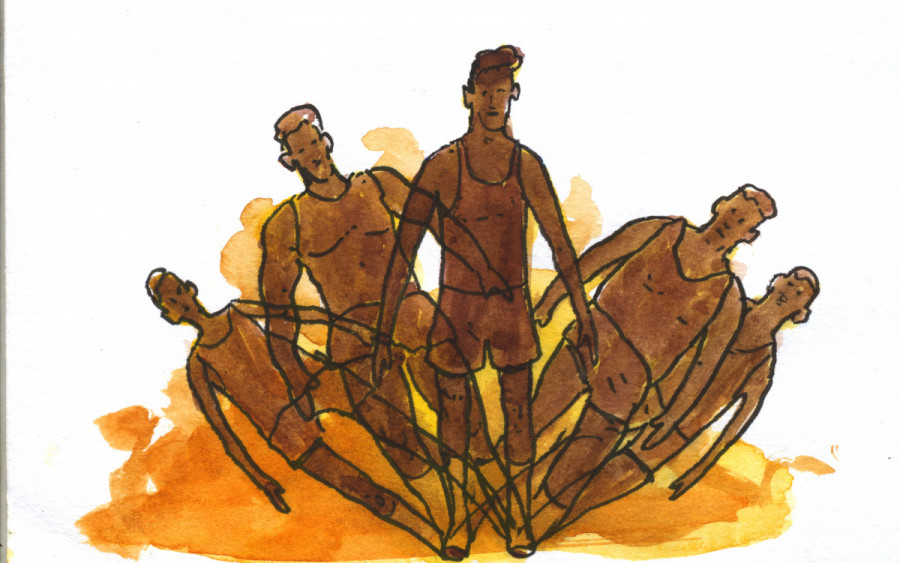Body image in sports: The athletic pressure to be “beautiful”
Athletes are expected to look a certain way, even when it is not relevant to performance
TW: This article discusses body image issues.
“They would hide the cookies from me because they thought I was eating too many of them.”
As a 10-year-old boy, Mahmoud Babiker would start his day with a regimen of 20 push-ups, 20 sit-ups, 10 crunches, 30 jumping jacks, and two minutes of wall sits.
“The reason why my parents put me in sports was because I was a chubby kid,” said Babiker, now 28 years old and an amateur boxer. “You can imagine the message that sent to me.”
From a very young age, Babiker’s parents noticed he was taller and bigger than his siblings and peers—something they saw as a problem that needed to be solved.
“They put me in karate, soccer, track and field, and boxing to make sure I lost weight. I hated it. I hated exercise as a child,” he said. “My love for sports now comes as a form of therapy, but it began as resentment.”
Like that of many young athletes, Babiker’s journey in sports has been plagued with the pressure to look a certain way. The typical male athlete is expected to be tall, lean, with broad shoulders and great musculature, while the stereotypical female athlete has a smaller frame, well-defined though less bulky muscles, and very little body fat.
Athletes of all ages, genders, shapes, and sizes are forced to deal with this pressure and the debilitating effects it can have on their physical and mental health.
In women’s sports particularly, unrealistic and irrelevant patriarchal standards are often imposed. These include archaic uniform regulations, media objectifications, and the need to cater to male viewership. This all impacts how women in sports see themselves, how they are presented, and the expectations that young female athletes then have for their image and their bodies.
“When we got to 13, a lot of the girls started hiking their suits up to make them more revealing or appealing. It led to a lot of body insecurity and unnecessary competition among the girls, something that never happened with the guys,” said Jordan Mckay, former synchronized swimmer and competitive water polo player.

Mckay emphasized that for her, the pressure didn’t come solely from other athletes, but from coaching staff and parents as well.
Coaches started teaching Mckay and her teammates about nutrition and dietary suggestions when they were as young as 10. Coaching staff categorized Mckay and her peers into different types of competitions based on their changing teenage and prepubescent bodies.
“The coaches often made assumptions about what [events] kids should be competing in because of these standards. Because of those assumptions, I was forced into a box,” said Mckay.
This one size fits all approach was one of the most toxic parts of swimming culture, Mckay said. All athletes underwent the same training, went to the same practices, participated in the same events, but when results varied and athletes underperformed, they and their bodies were to blame. This caused athletes like Mckay to overwork and overtrain themselves, resulting in painful and recurring injuries.
“[Injuries are] weaknesses that are treated like crutches or nuisances rather than problems, and are rarely addressed. I’ve had people ridicule me, claim I’m lying and even [ignored me],” Mckay added. “If you’re injured for too long, coaches will usually give up on finding solutions. If you don’t meet the impossible standards, coaches will usually just give up and forget about you.”
Due to her strict training regimen and the competitive swimming culture, Mckay has suffered numerous injuries to her upper body, involving chronic bodily pain and tissues that have never healed to this day.
“I broke my body trying to achieve the standards that were set out for me,” she said.
As a result, she has endured mental health issues such as eating disorders, intense anxiety, depression, and body image problems. When asked whether there were resources for her to deal with her health problems, she stated there were absolutely none.
“I broke my body trying to achieve the standards that were set out for me.” — Jordan Mckay
Mental health problems and body image standards in sports seem to go hand in hand, and the problem particularly affects teen athletes.
Multiple studies have demonstrated that hormonal changes and puberty can create mental states that are vulnerable to body image and self-confidence issues. This ties to the competitive nature of many athletes and sports that encourage perfectionism to enforce rigid discipline, which can lead to compulsive behaviour.
For young athletes with often busy schedules, controlling body image is a way of demonstrating ownership of themselves, especially for teenagers navigating their way through the many changes and challenges associated with that period of growth .
Physical education teacher and former McGill football player Kamba Manueli Katchelewa talked about the importance of creating a judgment-free, skill and performance-based sports culture that addresses individual needs and provides resources for growing athletes.
As a former university-level athlete, Katchelewa described the tough guy mentality and toxic locker room culture that comes with certain sports such as American football. He spoke on the need to eliminate cultures that allow athletes to judge, make fun of, and pressure each other in groups.
Katchelewa explained the toll this sports culture took on fellow athletes at the university level who could not make time for themselves to take care of their mental health and bodies.
“A lot is expected of athletes. You’ve got training, performance, and you’re constantly scrutinized,” said Katchelewa. “Everyone talks about you all the time. However, at the end of the day, you’re still human, you’ve still got feelings.”
Parents, coaches, and training staff have a responsibility to provide emotional support, treat body dysmorphia with mental health services, provide nutritional advice that is not detrimental to athletes’ bodies, and create healthy team cultures.
Katchelewa stressed that the need is more pressing than ever for teenage athletes.
“If coaches talk about bodyweight, it should strictly be about performance,” he said, emphasizing the importance of performance that is sustainable to an athlete and their individual capabilities.
“To see someone that looks like you, to see that it’s possible, it gives you confidence that you have a way to go to that place” — Kamba Manueli Katchelewa
At the international level, however, world-class competitors such as Serena Williams, Nikola Jokic, Andy Ruiz Jr., Isaiah Thomas, and Tyson Fury are defying body ideals and doing it with success. Commentators have called them too short, too athletic-looking (or not athletic-looking enough), too fat, too small, or physically undesirable. Despite this, these athletes have broken norms and perceptions in their respective sports, going so far as to become international champions and MVP candidates.
“I think it’s great, and honestly the biggest thing for me growing up was representation,” said Katchelewa. “To see someone that looks like you, to see that it’s possible, it gives you confidence that you have a way to go to that place.”
In this process, these elite athletes have inspired and are influencing new generations of sports players to embrace their natural bodies and work with them in a way that is conducive to both their success and their health. By breaking the old standards and attitudes towards body shapes, they are paving the way to a world of sports that is more inclusive and less judgemental.
“We need to change our way of thinking about [amateur] athletes,” said Mckay. “[We need to let] amateur athletes develop all skills equally instead of focusing on archaic ideas about bodies. We also need to focus on treating mental health and injuries with more sensitivity than we ever have before.”
This article originally appeared in The Body Issue, published February 1, 2022.


_600_832_s.png)


4_600_375_90_s_c1.jpg)

